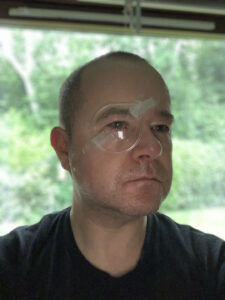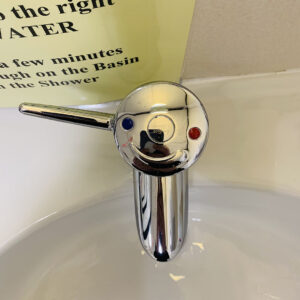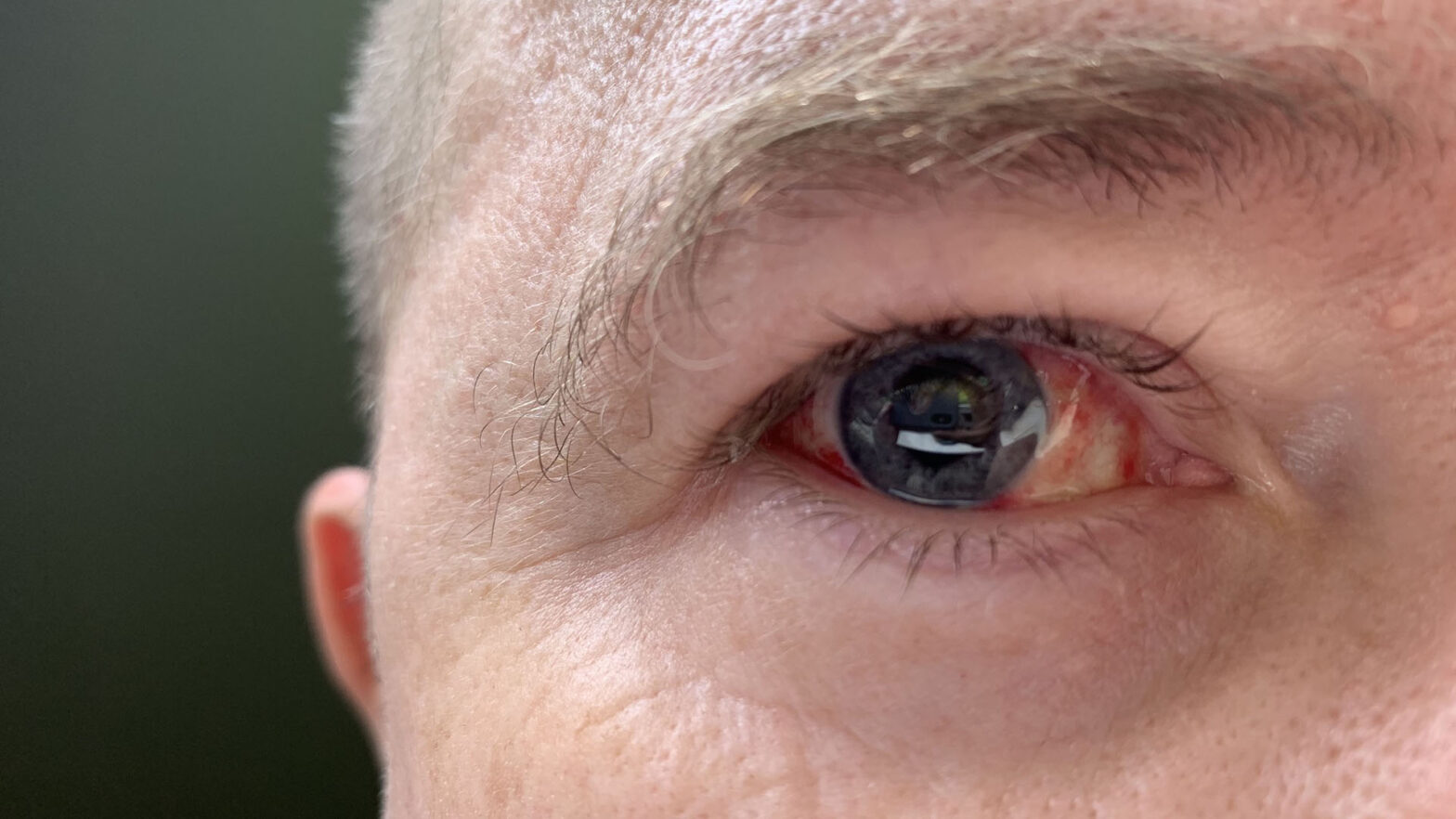After five major eye surgeries for a detached retina I’ve written a new reflective blog post describing my experiences to date. I’ve illustrated my vision loss for each medical procedure and current condition to potentially help others going through similar medical journeys.
Lack of visual resources
When researching my surgical procedures beforehand I had some difficulty sourcing any visual depictions of what to expect. The majority of resources were text-based academic papers.
Hopefully my open-licensed illustrations and interactives can help others mentally prepare for some visceral and disconcerting sight anomalies.
Hidden disabilities
My second motivation for writing this post is to do with raising the awareness of hidden disabilities. As with my type 1 diabetes (T1D), sight loss can be sometimes impossible to detect. It’s also maybe useful to hear from different voices on their invisible illnesses, the sight loss spectrum is broad and this is very much my own particular journey I’d like to share.
What has happened?

I’ve blogged previously about coping with my initial retinal detachment and how it impacted my work:
Struggling with vision loss (first published 4 June 2020)
Since then I’ve had five major surgeries and subsequent traumatic detachments.
I now have permanent sight loss in my right eye, specifically severe blurred vision and the inability to read anything with that eye (regardless of size or distance).
What is a detached retina?
At this point it’s maybe worth clarifying what precisely a detached retina is. Over the last year I’ve had a few awkward conversations with friends that have mistakenly assumed it meant a dislocated eyeball.
Technically a detached retina is when the thin layer at the back of your eye (retina) becomes loose. There are a number of reasons why people experience this condition, mine is directly related to my T1D.
Visual diary
I kept a personal diary of each milestone in iOS Notes and a visual record of my vision loss on my MacBook. These digital sketches were created in Adobe Photoshop and depict each visual acuity test I undertook. Technically these are called logMAR charts, or more specifically a ETDRS Chart R.
Medical timeline
This interactive timeline should provide some understanding of the highs and lows I’ve experienced in the last 10 months. Please note this timeline contains simulated logMAR charts for only my affected right eye at a four metre reading distance.
N.B. All Scottish lockdown dates taken from the following Wikipedia page: Timeline of the COVID-19 pandemic in Scotland
How do you measure a year?
- Five major vitrectomy surgeries
- Two gas bubbles and three silicone oils
- 15 stitches in my right eye
- 12 bottles of eye drops
- Chloramphenicol (antibiotic)
- Dexamethasone (anti-inflammatory)
- Dorzolamide / Timolol (hypertension)
- One trip to Accident and Emergency
- Four trips to the opticians
- One fainting episode (overwhelmed by prognosis)
- 18 appointments at Edinburgh’s Princess Alexandra Eye Pavilion
- Countless tears
What happens during a vitrectomy surgery?
Vitrectomy is a surgery to remove some or all of the vitreous humour from the eye, i.e. the eye’s clear internal jelly. Gas can be used to help hold the retina in place, this is referred to as a retinal tamponade.
Gas, or more typically mixed gas and air, is injected through the sclera (white outer layer) and into the posterior segment of the eyeball. The retinal tamponade acts to hold the retina in place or temporarily seal off holes in the retina.
The gas bubble slowly gets smaller and disappears after either 10 to 12 days or six to eight weeks after the operation, depending on the type of gas used. As this happens the space that was taken up by the gas is filled with aqueous fluid – the natural fluid made by the eye.
What does a gas bubble look like?
Whilst waiting for the gas bubble to dissolve the vision in your eye is very poor, similar to having your eye open underwater. After the gas has been absorbed, your vision should normally improve.
I’ve created a simple H5P interactive simulating the vision loss in my right eye after having a gas bubble inserted. Drag the white slider horizontally to see gas bubble, retinal detachment and 20/20 comparisons.
Thank you Julie
Thank you to Julie Freeman for these beautiful white flowers she kindly sent me after my first surgery.
N.B. The Prosecco it came with was not around long enough to be photographed.
Silicone oils
The other surgical tamponade used during a vitrectomy is a silicon oil. I’ve previously had two heavy silicon oils (HSO) and currently have a standard silicone oil (SSO).
The major side effects of the SSO for me are:
- Screen glare (halo and double-vision effects)
- Poor depth perception
- Linear distortions (oil warping straight lines)
- Low-level pain and the occasional pang (thankfully I normally respond reasonably well to analgesics)
This final interactive is designed to simulate my current vision and what impact the SSO has compared to standard vision. I’ve chosen my iPhone Camera app as a fairly common task for me and one that highlights each of the different side effects I experience.
These visual anomalies are significantly more pronounced at night, or if the digital device is in close proximity. They also vary in response to other factors like physical activity, tiredness, stress and sunny weather.
Am I registered as partially sighted?
I’ve had a few people ask me this question, but with significant visual impairment in only one eye my sight loss is not certified.
Official registration takes into account the total amount of vision present – either with two eyes or only one. Since I’m fortunate to still have good vision in my left eye it’s not classed as “sight impaired” or “partially sighted”.
Therefore I have “vision loss”, but I am not sight impaired or partially sighted. The language I use to describe my situation is very important for me. I’m attempting to be both accurate and sensitive with my word choice.
Prognosis and moving forward

My left eye at the minute has thankfully no major vision issues for me, only moderate sized, persistent floaters. It has already been treated for serious diabetic retinopathy, so I suppose there will always be the possibility of future issues.
Living long-term with a silicone oil in my right eye could potentially introduce new complications such as:
- Ocular inflammatory reactions
- Increased intraocular pressure (IOP)
- Cataract formation
- Emulsification
These things may never happen and I’m honestly very grateful for what sight we’ve managed to salvage.
My consultant is relatively pleased with things at the minute, the retina looks stable (i.e. attached). Ocular pressure was slightly elevated post-surgery causing moderate pain and discomfort, but after an adjustment to my eye drops things have improved.
No more surgeries

After five procedures, any further surgeries to improve my sight have now been ruled out. It could been seen as slightly perverse, but I’m honestly relieved.
The psychological impact of consecutive unsuccessful surgeries and not knowing what to expect next has been both traumatic and exhausting. Even after living with T1D for over 20 years, it’s still upsetting to have your body fail you again. You get told the odds and probable reasons for your situation but it’s a bitter pill to swallow. Confidence about my health, in particular my eye, is probably at an all time low.
However, the thought of fewer hospital appointments positively fills me with glee, as do the possibilities of brand new personal and professional challenges.
I’ve been back at work four weeks and I’m thankful to have agreed a phased-return with my exceptional line manager Karen Howie. It’s very tough adapting to my new limitations, but I do feel supported and hopeful about my future.
Upcoming blog post
In a future post I’ll expand on my recovery process, in particular how I’m adapting to vision loss with the help of Lego model building.
Lego Main Library (first published 28 April 2021)
Support and further reading
Charity fundraiser
Please consider donating to my charity fundraiser Lego challenge for Sight Scotland.
Sight Scotland
For more than 225 years, they have been supporting people with sight loss and blindness. They are one of Scotland’s oldest charities and are dedicated to empowering people with visual impairments to lead fulfilling lives. What they do:
- Provide care and support that empowers people affected by sight loss in Scotland.
- Fund research into cures and treatments for blindness and sight loss.
- Campaign for equal opportunities for people with sight loss to participate fully in society.
Visibility Scotland
Visibility Scotland is a charity supporting children and adults who are blind or partially sighted and live in Scotland. They also offer support to families and carers of anyone affected by sight loss.
Trusted healthcare resources
RNIB information on retinal detachment
Copyright and licence
The text, images and interactives published within this post are all intended to be shared, reused and remixed. In order to encourage this I’ve applied a Creative Commons open licence to my own content where the only requirement is to include the following attribution.
Copyright © Stewart Lamb Cromar 2021 CC BY.
This work is licensed under a Creative Commons Attribution 4.0 International License.
Download, reusing and remix assets
Photographs and illustrations have been published to my personal Flickr account:
You can save any H5P object to your local machine with two simple steps:
- Click “Reuse” button
- Click “Download”
The file is now saved on your local machine. Please note you can’t open an H5P file on your machine, it has to be uploaded to a site supporting H5P.
Other credits
LogMAR chart
By user Fvasconcellos. Public domain, via Wikimedia Commons.
Disclaimer
Please note these resources are entirely a personal record of my own experiences and have not been verified by any qualified medical professionals or other individuals from the University of Edinburgh.
Last updated
This post was updated 15 April to add a link to my Sight Scotland charity fundraiser challenge.

Comments
10 responses to “My sight loss journey”
Interesting blog, Stubot, and a very good idea to record your journey, with all its highs and lows.
Thank you Shirley, I appreciate you taking the time to read this. Yes, it’s been invaluable when trying to remember everything clearly. Love, Stubot 🤖 x
Hi Stewart
I’ve only just heard about your eye problems and read you blog. I’m really sorry, it must have been a terrible experience especially during the COVID pandemic. It looks as though you have at least reached some stability with your vision so I am pleased about that. Guess you’re still working at Edinburgh?
All is well here. Amelie is now 9 years old – hard to believe. Most of my time is spent gardening, playing a bit of golf, walking, reading and of course home-schooling (during various lock-downs) and the school run. Caroline also sends her love and best wishes. David
Hello David, thank you for taking the time to read my post and get in touch. It’s very nice to hear about you and Caroline, I’m glad you’re all keeping well (can’t believe Amelie’s 9 either!). It has been tough, but writing about it has helped, almost cathartic, and having friends reach out to send kind wishes is very much appreciated. Take care and please say hello to Caroline too. Stewart 🤓
Stewart, I had no idea you were going through this all. I am so sorry, but deeply appreciate your willingness to share what you are experiencing. My father has lost almost all of his sight over the past year due to severe glaucoma, and your blog has helped me understand a bit more of his perspective (which he doesn’t really talk about). Kristina x
Hello Kristina. Your personal comment means so much to me. I am very sorry to hear your dad’s sight has deteriorated further. It made all the difference to me having the support of family & friends and I’m confident you’re helping him immeasurably too. Reading that you found this blog useful has made me very happy, thank you for getting in touch. Stewart x
Hi Stewart, I found this post via a tweet from our colleague Anne-Marie Scott. Thanks for sharing this painful experience and also for the creative approach to using H5P to provide a simulation to understanding what it’s like for you. And also, kudos for being so detailed on attribution of media.
This is very close to home for me as I am 50 years T1D and have had my brushes with diabetic retinopathy. I had intense rounds of laser surgery in the mid-1990s and have been fortunate to have much loss of vision beyond peripheral and some floaters. I had a flareup while traveling in the UK in 2018 (I received amazing NHS care in Chicester) where left eye vision deteriorated to a blur. I was able to recover from that with an injection that stopped the bleeding, but that one scared me again into more rigorous blood sugar control.
Your efforts here are inspiring and I hope you can continue seeing and doing as much as possible.
Hello Alan!
Thank you for the very personal feedback, it’s incredibly helpful for me to hear from others about their own T1D journeys.
Glad you liked the H5P objects, I often get asked what my vision is like and this seemed a perfect opportunity to me.
It’s only been up a few a few days, but it’s already exceeded my expectations. Thank you again for reaching out to me, take care.
Stewart 🤓
[…] Lego. As an adult fan of Lego (AFOL) this was a perfect match for me, but even more so after my recent sight loss. Lego model building has been helping me adapt to reduced depth perception and I’ll expand on […]
[…] spotted more H5P in a moving blog post by Stuart Lamb Cromar (University of Edinburgh) sharing his loss of vision due to a detached […]